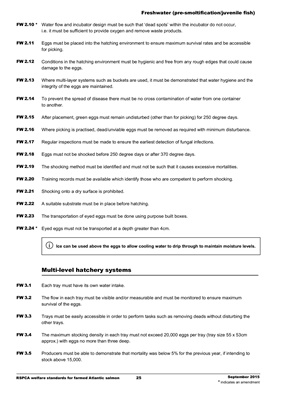
Freshwater (pre-smoltification/juvenile fish)
RSPCA welfare standards for farmed Atlantic salmon 25 September 2015
* indicates an amendment
FW 2.10 * Water flow and incubator design must be such that 'dead spots' within the incubator do not occur,
i.e. it must be sufficient to provide oxygen and remove waste products.
FW 2.11 Eggs must be placed into the hatching environment to ensure maximum survival rates and be accessible
for picking.
FW 2.12 Conditions in the hatching environment must be hygienic and free from any rough edges that could cause
damage to the eggs.
FW 2.13 Where multi-layer systems such as buckets are used, it must be demonstrated that water hygiene and the
integrity of the eggs are maintained.
FW 2.14 To prevent the spread of disease there must be no cross contamination of water from one container
to another.
FW 2.15 After placement, green eggs must remain undisturbed (other than for picking) for 250 degree days.
FW 2.16 Where picking is practised, dead/unviable eggs must be removed as required with minimum disturbance.
FW 2.17 Regular inspections must be made to ensure the earliest detection of fungal infections.
FW 2.18 Eggs must not be shocked before 250 degree days or after 370 degree days.
FW 2.19 The shocking method must be identified and must not be such that it causes excessive mortalities.
FW 2.20 Training records must be available which identify those who are competent to perform shocking.
FW 2.21 Shocking onto a dry surface is prohibited.
FW 2.22 A suitable substrate must be in place before hatching.
FW 2.23 The transportation of eyed eggs must be done using purpose built boxes.
FW 2.24 * Eyed eggs must not be transported at a depth greater than 4cm.
Ice can be used above the eggs to allow cooling water to drip through to maintain moisture levels.
Multi-level hatchery systems
FW 3.1 Each tray must have its own water intake.
FW 3.2 The flow in each tray must be visible and/or measurable and must be monitored to ensure maximum
survival of the eggs.
FW 3.3 Trays must be easily accessible in order to perform tasks such as removing deads without disturbing the
other trays.
FW 3.4 The maximum stocking density in each tray must not exceed 20,000 eggs per tray (tray size 55 x 53cm
approx.) with eggs no more than three deep.
FW 3.5 Producers must be able to demonstrate that mortality was below 5% for the previous year, if intending to
stock above 15,000.
i